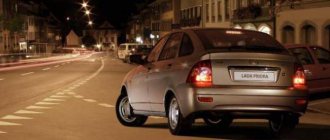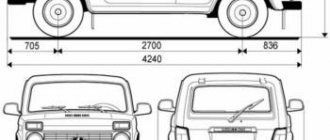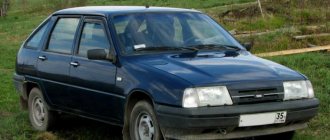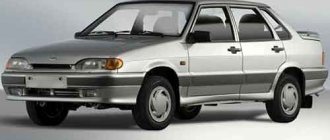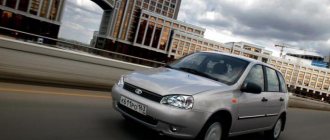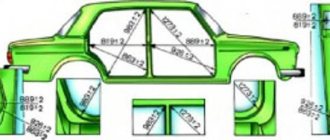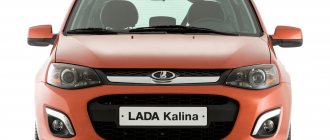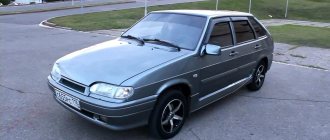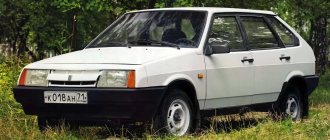So, VAZ 2107 technical characteristics, dimensions, parameters.
VAZ 2107 was produced from March 1982 to April 2012. It has been produced in Egypt since 2006 to this day.
It has a 5-seater sedan-type body, in-line 4-cylinder gasoline engines, paired with a 4 or 5-speed manual transmission. It is included in the class of subcompact cars, according to the European classification - class “B”. And not C, as they say on the forums. C class is Ford Focus, KIA Ceed, etc. Wheel formula 4x2, rear wheel drive. The ancestor is the Italian Fiat 124.
General parameters of the VAZ 2107
Length - 4145 mm Width - 1620 mm Height - 1446 mm Base - 2424 mm Front wheel track - 1365 mm Rear wheel track - 1321 mm Ground clearance - to the front suspension cross member - 159 mm, to the rear axle beam - 154, up to muffler housing - 120 mm. Not bad, for example in the Opel Zafira, only 150 mm to the highest point. Load capacity - 400 kg Trunk volume - 385 liters Curb weight - 1060 kg Gross weight - 1460 kg Towed trailer weight, without brakes - 300 kg, with brakes - 600 kg.
History of creation
The new and how it ended up being the most prestigious car of the 80s, a rear-wheel drive sedan with the factory designation VAZ-2107, appeared on the Soviet market in 1982. By analogy with how the luxury version of the “troika” with the factory index VAZ-21031 became a separate model called the VAZ-2106, in the same way the VAZ-2107 was developed as a luxury version of the “five”.
As a result, compared to the basic “five,” the VAZ-2107 turned out to be more modern and was very popular. Like previous cars of the Volzhsky Automobile Plant, it was actively exported to various countries under the names Lada Nova, Lada Riva, Lada Signet, Lada 1500.
Starting from 2002, Ukraine began to assemble the “seven” into cars; it was to him that AvtoVAZ sold the license to produce the VAZ-2107 car. A year later, the production of VAZ-2107 cars was transferred from Togliatti to Syzran to the Rollada enterprise, from that moment on, the “seven” was assembled anywhere, but not in Tolyatti.
The last Russian car VAZ-2107 with the simple popular name “seven” rolled off the car assembly line in 2012 , which is not surprising because the design of the car has long been outdated. One could have put an end to this, but it was not to be, the “seven” was mass- produced in Egypt for another two years until the beginning of 2014 . Thus, we can say with confidence that the end of the “classic” era came in 2014 with the discontinuation of the VAZ-2107 car.
VAZ 2107 engines
The VAZ 2107 was equipped with several engines (for Russia and the USSR), these are:
- VAZ 2103 engine (8 class, 1500 cm3, 71 hp, carburetor)
- VAZ 2105 engine (8 class, 1300 cm3, 64 hp, carburetor, timing belt drive)
- VAZ 2106 engine (8 class, 1600 cm3, 79 hp, carburetor)
- VAZ 2104 engine (8 cells, 1500 cm5, 68 hp, central injection)
- VAZ 21067 engine (8 cells, 1600 cm3, 74 hp, distributed injection)
- RPD engine (rotary, 1300 cm3, 140 hp)
Piston diameter and stroke:
- for 1300 = 79 mm x 66 mm - for 1500 = 76 mm x 80 mm - for 1600 = 79 mm x 80 mm - for 1700 = 82 mm x 80 mm
Compression ratio for all engines - 8.5 Cylinder operating order: 1-3-4-2
For carburetor VAZ 2107, DAAZ 2107-1107010 carburetors and their modifications were used. A-92 gasoline is used as fuel.
The injector for Euro-3 standards is already designed for A-95 gasoline.
Spark plugs for VAZ 2107:
— for carburetor engines — A17DVR or A17DV-10; - for injector - A17DVRM.
Oil for VAZ 2107:
For all classic engines, the optimal choice is semi-synthetic 5W40. If your region has severe frosts, and most of the time it is below minus 30, then choose 0W40. If your frosts are not severe and the summer is hot, then the oil is better than 10W40.
Oil change is done once every 10,000 km
Machine weight characteristics
For its time, the VAZ 2107 was an excellent car that was successfully sold, including outside our country. The machine's technical characteristics were not inferior to its analogues at a lower price; the design scheme used is highly reliable. The weight of the equipped vehicle is just over a ton, which allows it to demonstrate good power capacity.
The maximum permissible load is 400 kg, in other words the car can carry five adult passengers. If the quantity is smaller, luggage can be transported in a special compartment. A rational distribution of masses between the axles ensures good stability and controllability of the vehicle.
The small dimensions of the VAZ 2107 model, optimal weight for its size and a powerful engine provide the car with good dynamics and maneuverability. The successful design and low price predetermined the car's commercial success and, despite its advanced age, it still does not lose popularity.
VAZ 2107 is a rear-wheel drive car of group II of the small class of the AvtoVAZ company, produced from 1982 to 2012.
Body dimensions of VAZ 2107:
- VAZ 2107 2107 1.5 MT (72 hp): 4145x1620x1440 (mm).
- VAZ 2107 2107-20 1.5 MT (68 hp): 4145x1620x1440 (mm).
Dimensions are given in length/width/height format.
Additional sizes:
Modification track size:
Note:
- VAZ 2107 body type: sedan (4 doors, 5 seats).
- Standard clearance size: 170 (mm).
Important: the wheelbase size of the VAZ 2107 modifications is 2424 (mm).
Other names:
The 4-door VAZ 2107 sedan was exported under the names Lada Nova, VAZ 2103, VAZ 1500, Lada Riva, Lada Signet, Lada 1500.
Years of production years of production of all modifications of the model: 1982-2014.
| VAZ 2107 1982 - detailed dimensions |
| VAZ 2107 1990 - detailed dimensions |
| VAZ 2107 bodies - detailed dimensions |
| VAZ 2107 cylinders - detailed dimensions |
| General parameters of VAZ 2107 bodies | |||
| General view General view of bodies | Length min (mm) Minimum overall vehicle length for different modifications of VAZ 2107 | ||
Measured in millimeters (mm)
Measured in millimeters (mm)
| Length max (mm) Minimum overall vehicle length for different modifications of VAZ 2107 | Modifications Number of modifications of the model in our database | ||
| (General form) | 4145 (mm) | 4145 (mm) | 8 |
| VAZ 2107 body parameters | |
| Parameter Body parameter | |
Caution: the above data are the official figures of the manufacturer, however, please note that the information is for reference only and does not guarantee absolute accuracy.
The main task facing the designers was to reduce fuel consumption and the amount of exhaust gases, as well as improve the comfort and safety of the driver and passengers. In general, the task was completed successfully, since twenty years later the price of the outdated car did not drop in price, despite the fact that it lagged well behind its competitors.
VAZ 2107 body
All-metal, load-bearing, with 4 doors. Body rigidity - 7200 Nm/deg.
The width of the VAZ 2107 interior , and all classics in general (from the rear door trims at the seat level) is 1250 mm. Between the central pillars of the cabin, at a level of 80 cm from the floor - 1234 mm.
The length of the front door opening of the VAZ 2107 (and all classics) is 889 mm, the rear door is 819 mm.
Dimensions of the trunk of the VAZ 2107:
General view
ATTENTION! A completely simple way to reduce fuel consumption has been found! Don't believe me? An auto mechanic with 15 years of experience also didn’t believe it until he tried it. And now he saves 35,000 rubles a year on gasoline! Read more". The exterior of the “Seven” generally copies other VAZ models, called “classics”
On the other hand, some parts and components of the frame are not the same. They simply will not fit the general exterior due to the fact that they differ in basic parameters
The exterior of the “Seven” generally copies other VAZ models, called “classics”. On the other hand, some parts and components of the frame are not the same. They simply will not fit the general exterior due to the fact that they differ in basic parameters.
Let's start with the front. This area of the car includes these components: the hood, the apron with the front bumper (they are considered more decorative elements) and the fenders.
As for the middle part of the car, this includes the roof of the VAZ 2107, sills, and doors.
Finally, the rear of the car includes the fenders, boot lid and rear apron.
All main body elements are made of stamped steel, additional ones are made of plastic. If minor damage occurs, they can be easily straightened and, if necessary, replaced with new ones without much difficulty.
Comparatively, the “seven” looks more modern than other “classic” models. It is for this reason that the car remained on the production line, although the designers did not make any significant changes.
The car interior is equipped with 4 seats. The front seats are made in the form of an independent adjustable design. As for the rear ones, they have no adjustment. The interior lining is plastic, the roof is covered with leatherette.
The interior of the “Seven” is structurally excellently protected from frontal and rear impacts, but a side collision with another car can lead to catastrophic consequences.
Electrical equipment VAZ 2107
Wiring type: single-wire, negative on the car body (ground).
Battery: 6ST-55, capacity 55 Ah. Batteries with a capacity of 60 and 65 Amperes are also suitable, but you need to check the dimensions. Typically it is 242mm x 175mm x 192mm.
Operating voltage in the network: 13.6 -14.6 volts. The generator (G221) must deliver a current of no more than 1/10 of the battery capacity, i.e. approximately 2 to 5.5 Amps.
Ignition coil - B117 or B117-A (for carburetor engines) Starter - ST221
Lamp type:
— low and high beam lamp: H4 or AKP2-60+55 (in Russian) — side marker lamp and side turn signals: T4W or A12-4-1 — turn signal lamp in the headlight, fog lights, reverse and brake lights: P21W or A12-21-3 - license plate and interior lighting lamp: C5W or AC12-5-1
Luggage rack manufacturers
Gutter racks have been produced since USSR times. But due to the bowl-shaped shape and the small number of points of contact with the load, Soviet designs have sunk into oblivion. Although they can be found today as a rarity or an “unkillable” platform for transporting agricultural products.
A typical representative of that era is the BelAZ gutter rack, which is still produced in Belarus to this day. Options for four and six supports differ slightly in load capacity. The total figure is 50 kg. Dimensions 1.3x1.05x0.21 m. Cost 1,200 and 2,500 rubles depending on the number of supports. Consists of 4 single and 4 paired black metal tubes. They occupy transverse positions. Perforated silver plates are screwed to the ends as side edges. The trunk's potential is limited by design.
Luggage basket made by BelAZ
Currently, luggage devices are made of lightweight, durable alloys using an anti-corrosion coating.
- from Rostov-on-Don is popular for its universal designs, but does not shy away from mounting on gutters. The basic model consists of six parts:
- Paw. Part of the support from the roof side.
- Clamp. Second part of the support.
- Pipe crossbar. It is made of square steel profile.
- Plastic plug. Before threading the crossbar into the rack, the plug is removed from the crossbar.
- Wing with nut. Main fastener.
- Rubber backing. She puts it on her paw.
Load capacity 70 kg. Price from 450 to 900 rubles depending on the length of the crossbars. An excellent budget option, but at speed it shows poor aerodynamics - it is noisy.
- The Ant trunk is no different in appearance from the previous one. But the price of 1,750 rubles is explained by a 2-year warranty.
- The Russian aerodynamic trunk consists of wing-shaped crossbars 8 cm wide and 125 cm long. They can withstand loads of up to 75 kg. A T-shaped groove for connecting accessories and corrosion protection will cost 3,520 rubles. The VAZ-2107 is not a weak car and, having high-speed characteristics, will only improve them due to the aerodynamic cross members.
Luggage baskets are installed on the Semerka. They create the necessary volume for small-sized personal items. But boxes on 2107 are a rare phenomenon. If only this is a car that has undergone exterior tuning. Then the shape of the airbox is combined with the curves of the car.
Video about installing a roof rack on gutters
At the end, two main rules should be added for installing luggage accessories on the drains of a VAZ-2107:
- Maintain alignment from the windshield and rear window.
- Tighten bolted connections evenly.
And also take care of the roof and operate the trunk in accordance with the instructions.
Refill containers
- Fuel tank (including 5 liter reserve) - holds 39 liters of gasoline
- Lubrication system (including oil filter) - holds 3.75 liters of oil
- Engine cooling system (including interior heater) - 9.85 liters of antifreeze
- Washer reservoir - 2 liters
- Gearbox housing - 1.35 liters of transmission oil (semi-synthetic GL-5 75W90) / for a 5-speed gearbox - 1.59 liters
- Rear axle housing - 1.3 liters semi-synthetic GL-5 (75W90)
- Clutch hydraulic system - 200 ml
- Brake system 660 ml
Main overall dimensions of the VAZ21011 car
- Repair manuals
- Repair manual for VAZ 2101 (Zhiguli) 1970-1985.
- Main overall dimensions of the VAZ-21011 car
↓ Comments ↓
1. Technical data 1.0 Technical data 1.1 Main overall dimensions of the VAZ-2101 car 1.2 Main overall dimensions of the VAZ-21011 car 1.3 Main overall dimensions of the VAZ-2102 car 1.4 Technical characteristics of cars 1.5 Controls and monitoring devices 1.6 Ignition switch 1.7 Ventilation and heating controls interior
2. Operation and maintenance 2.0 Operation and maintenance 2.1. Vehicle operation 2.2. Vehicle maintenance
3. Engine 3.0 Engine 3.1 Features of the device 3.2 Possible engine malfunctions, their causes and methods of elimination 3.3 Removal and installation of the engine 3.4 Disassembly of the engine 3.5 Assembly of the engine 3.6 Bench tests of the engine 3.7 Checking the engine on the car 3.8. Cylinder block 3.9. Pistons and connecting rods 3.10. Crankshaft and flywheel 3.11. Cylinder head and valve mechanism 3.12. Camshaft and its drive 3.13. Cooling system 3.14. Lubrication system
4. Fuel system 4.0 Fuel system 4.1. Power system 4.2. Carburetor
5. Ignition system 5.0 Ignition system 5.1 Setting the ignition timing 5.2 Gap between the breaker contacts in the ignition distributor 5.3. Checking ignition devices on a stand 5.4 Possible ignition malfunctions, their causes and methods of elimination
6. Starting and charging system 6.0 Starting and charging system 6.1. Battery 6.2. Generator 6.3. Starter
7. Transmission 7.0 Transmission 7.1. Clutch 7.2. Gearbox 7.3. Cardan transmission 7.4. Rear axle
8. Chassis 8.0 Chassis 8.1. Front suspension 8.2. Rear suspension 8.3. Shock absorbers 8.4 Possible malfunctions of the chassis, their causes and methods of elimination
9. Steering 9.0 Steering 9.1 Features of the device 9.2. Inspection, check and adjustment of steering 9.3. Steering mechanism 9.4. Steering rods and ball joints 9.5. Pendulum arm bracket 9.6 Possible steering malfunctions
10. Brake system 10.0 Brake system 10.1. Features of the device 10.2. Checking and adjusting brakes 10.3. Clutch and brake pedal bracket 10.4. Main cylinder 10.5. Front brakes 10.6. Rear brakes 10.7. Rear brake pressure regulator 10.8. Parking brake 10.9 Possible brake malfunctions, their causes and methods of elimination
11. Electrical equipment 11.0 Electrical equipment 11.1. Electrical circuit diagrams 11.2. Lighting and light signaling 11.3. Sound signals 11.4. Windshield wiper 11.5. Heater electric motor 11.6. Control devices
12. Body 12.0 Body 12.1 Features of the device 12.2. Repair of the body frame 12.3. Paint and varnish coatings 12.4. Anti-corrosion protection of the body 12.5. Doors 12.6. Hood, trunk lid, bumpers 12.7. Body glazing and windshield washer 12.8 Instrument panel 12.8. Removal and installation 12.9. Seats 12.10. Heater
13. Features of repair 13.0 Features of repair 13.1. Car VAZ-21011 13.2 Cars VAZ-21013 13.3. Car VAZ-2102 13.4 Cars VAZ-21021 and VAZ-21023
14. Appendices 14.0 Appendices 14.1 Tightening torques for threaded connections 14.2 Tools for vehicle repair and maintenance 14.3 Used fuels, lubricants and operating fluids 14.4 Basic data for adjustments and control
Suspension and wheels of VAZ 2107
Front suspension: independent, double wishbone, with anti-roll bar and hydraulic shock absorbers. Rear suspension: dependent, with a rigid rear axle beam and 5 reaction rods, on hydraulic shock absorbers.
Standard VAZ 2107 wheels: 5Jxl3H2 with an offset of 29 mm, mounted on 4 bolts with a hole diameter of 98 mm, hole diameter for the hub - 58.5 mm) Tires: tubed or tubeless 175/70R13 or 165/70R13
Recommended tire pressure: - front wheels - 1.7 kg/cm2 - rear wheels - 2.0 kg/cm2
For a softer and more comfortable ride, you can reduce it by 0.1 kg/cm2
Article: 21060-2402010-, additional articles: 21060240201000, 2106-2402010
Order code: 002789
- You may need
- show more
- Passenger cars / VAZ / VAZ-21061 drawing
» href=»/catalog/vaz-3/legkovye_avtomobili-30/vaz_2106-7/peredacha_glavnaya_i_differencial-114/#part20867″>Rear axle gearboxRear axle / Main transmission and differential
- Passenger cars / VAZ / VAZ-2120 “Nadezhda”1 drawing
» href=»/catalog/vaz-3/legkovye_avtomobili-30/vaz_2120__nadejda_-245/reduktor_i_differential_zadnego_mosta-120/#part56701″>Rear axle gearboxRear axle / Rear axle gearbox and differential
- » href=»/catalog/vaz-3/legkovye_avtomobili-30/vaz_2105-603/peredacha_glavnaya-71/#part1679377″>Rear axle gearboxRear axle / Main gear
- » href=»/catalog/vaz-3/legkovye_avtomobili-30/vaz_21213_214i-1240/reduktor_i_differencial_zadnego_mosta-203/#part2990163″>Rear axle gearboxRear axle / Rear axle gearbox and differential
- » href=»/catalog/vaz-3/legkovye_avtomobili-30/lada_4x4_m-1456/reduktor_i_differencial_zadnego_mosta-149/#part3241383″>Rear axle gearbox assemblyRear axle / Rear axle gearbox and differential
- » href=»/catalog/vaz-3/legkovye_avtomobili-30/vaz_2107-8/peredacha_glavnaya_i_differencial-155/#part25128″>Rear axle gearboxRear axle / Main transmission and differential
- » href=»/catalog/vaz-3/legkovye_avtomobili-30/vaz_2131-73/reduktor_i_differential_zadnego_mosta-196/#part64636″>Rear axle gearboxRear axle / Rear axle gearbox and differential
- » href=»/catalog/vaz-3/legkovye_avtomobili-30/vaz_21213-731/reduktor_i_differential_zadnego_mosta-149/#part2010787″>Rear axle gearboxRear axle / Rear axle gearbox and differential
- » href=»/catalog/chevrolet-125/legkovye_avtomobili-30/chevrolet_niva_1_7-1233/reduktor_i_differencial_zadnego_mosta-171/#part2974699″>Rear axle gearbox assemblyAxles / Rear axle gearbox and differential
- There are no reviews for this product yet.
Today, the next article in the series “Crystal VAZs or typical breakdowns of domestic cars” is dedicated to the “classics”: VAZ-2101, 2103, 2104, 2104, 2105, 2106 and 2107. These cars have been driving along our roads for decades and, despite Despite all the shortcomings that we will talk about, their popularity is still high.
Part two. Corrosion
Causes of corrosion and sources of its damage Corrosion is the process of self-destruction of a material in the process of interaction with the environment. In our case, metal corrosion occurs due to:
- Winter “urban” operation;
- Cheap body restyling, under which all kinds of dirt accumulates;
- Storing the car in damp, unventilated areas.
Places of the VAZ 2101 body most susceptible to corrosion
As the experience of most car owners shows, parts of the VAZ 2101 body that are most susceptible to corrosion are located in hard-to-reach places where moisture does not evaporate for a long time (gaps, bends, flanges), namely:
- wheel arches;
- hinged elements and places of their attachment (hood, trunk, doors, sills, fenders).
And if no measures are taken, then it can move to other, more significant power elements (spars, joints of the sub-engine frame, central pillars, etc.). Depending on the degree of surface destruction, it depends on how we will restore the damaged part.
Stage one
The oxidation process is in the initial stage (chips, scratches), only a slight color change has occurred. At this stage, you can get by with small losses - cleaning the surface with a fine abrasive wheel and then polishing the surface.
Stage two
Both the color of the paint changes and its swelling occurs, that is, the destruction process occurs evenly over the surface of the element.
Corrosion of the rear wheel arch of a VAZ 2101
This type of corrosion is not so terrible; it most often occurs due to poor preparation of the element for painting. It can be relatively easily cured by repeated stripping and subsequent filling with cold-set epoxy mastic. This type of mastic has high strength, sufficient adhesion, and is easy to apply to the damaged area. It contains plasticizers and hardeners, which increase the plasticity of the resin and its impact strength, as well as fillers that reduce the shrinkage of the resins and ensure that the coefficients of thermal expansion of the metal and the resins are brought closer together.
Stage three
In this case, the destruction process already goes deep into the metal (spots, cavities, holes), which requires deeper cleaning of the affected element followed by soldering (tinning) or replacement of the entire element or its individual parts.
Tinning the body of a VAZ 2101 with tin
By the way, if you heat the metal with a torch flame to a light red glow and at the same time it does not begin to crumble into gushing sparks, then it can still be used for welding. Well, when the VAZ 2101 body parts cannot be restored at all, I replace them with new ones using resistance welding and electric welding operating in a gas environment (semi-automatic). Most often, the front and rear fenders with panels require replacement. Methods for repairing and replacing these parts can be taken as basic; to do this, you just need to find out the location of the seams for joining the elements:
Welding seams of the front tail
Welding seams of the rear tail
Front and roof welds
Rear and roof welds
To obtain optimal rigidity of elements with minimal deformation, it is best to weld parts every 50 millimeters, using small ties of 20 millimeters. As you have already noticed, do-it-yourself body repair of a VAZ 2101 is a very labor-intensive and responsible process, the quality of which directly affects the safety and service life of the car.
